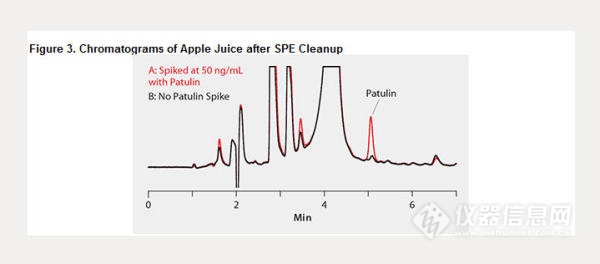Supelco launches patulin MIP molecularly imprinted SPE column - Database & Sql Blog Articles
Patulin is a mycotoxin produced by various fungal species, with Penicillium being one of the most common sources. It often contaminates spoiled apples and apple-based products such as juice and puree. Due to its potential health risks, including immunotoxicity and genotoxicity, more than 50 countries, including the U.S. and the EU, have set strict limits on patulin levels in food products.
The U.S. FDA has established a maximum limit of 50 μg/L for patulin in juice, while the EU sets a limit of 50 μg/kg. These regulations highlight the importance of accurate and efficient detection methods to ensure consumer safety.
Traditional methods for detecting patulin, such as liquid-liquid extraction followed by HPLC-UV, are time-consuming and require large amounts of solvents. As a result, there's a growing need for simpler, faster, and more environmentally friendly sample preparation techniques.
The SupelMIP molecularly imprinted SPE series offers a promising alternative. These cartridges are made from highly crosslinked polymers that are specifically designed to bind to target analytes like patulin. During the synthesis process, the template molecule is used to create a "molecular imprint" that precisely matches the shape and chemical structure of the target compound, ensuring high selectivity and efficiency.
Thanks to their high specificity, MIP-based SPE products can withstand harsh washing conditions without losing performance. This makes them ideal for complex matrices like apple juice, where unwanted compounds may interfere with detection.
Key features of the SupelMIP SPE products for patulin analysis include:
- Fast and easy method
- High selectivity and sensitivity
- Ability to handle tough cleaning steps
- Compatibility with mass spectrometry (MS)
The following procedure was used to analyze patulin in apple juice using the SupelMIP SPE technique:
- Dilute the apple juice with 2% acetic acid solution
- Activate the cartridge with 2 ml acetonitrile and 1 ml deionized water
- Load 4 ml of the diluted sample onto the cartridge
- Rinse with 1 ml of 1% sodium bicarbonate, followed by 2 ml of deionized water under strong vacuum for 10–15 seconds
- Elute the patulin with 2 ml of ethyl acetate
- Evaporate the eluate to near dryness and re-dissolve it in 1 ml of 0.1% aqueous acetic acid
Throughout the process, the flow rate should be maintained at 1–2 drops per second for optimal performance.
Experimental results showed that the SupelMIP SPE method provided excellent recovery rates and reproducibility, with an average recovery of 84%. The chromatogram confirmed that no interfering substances were detected, demonstrating the effectiveness of the MIP technology in eliminating background interferences like HMF and other impurities.

In conclusion, the use of SupelMIP molecularly imprinted SPE cartridges for patulin detection in apple juice is a reliable and efficient approach. The method not only improves recovery and accuracy but also reduces the risk of matrix interference, making it suitable for low-level detection in complex samples.
| Related Products | Description | Packaging | Product No. |
| SupelMIP SPE Product Patulin Column | 3 mL | 50pcs/box | 52776-U |
| Ascentis Express Column C18 | 15 cm x 2.1 mm ID, 2.7 um particle size | 153825-U | |
| Analytical standard Patulin | 32759-5MG, 100 μg/mL dissolved in acetonitrile | 1 | 34127-2ML |
| Chromatography solvent acetonitrile | 4X4L | 34851 | |
| ethyl acetate | 4X4L | 34858 |
Key Components
1. Solar Panels (Photovoltaic Arrays): These are the primary components that convert sunlight directly into electricity through the photovoltaic effect. The number of panels required depends on the amount of power needed and the intensity of sunlight in your location.
2. Charge Controller: This device manages the flow of electricity from the solar panels to the battery bank. It prevents overcharging and ensures the battery operates efficiently.
3. Battery Bank: Typically consisting of multiple deep-cycle batteries connected in series or parallel, the battery bank stores the electricity generated during daylight hours for use at night or when the sun is not shining.
4. Inverter: Converts the direct current (DC) stored in the batteries into alternating current (AC), which is usable by most household appliances and devices.
5. Load Management System: Helps to control the usage of electrical devices based on the available power from the battery bank, ensuring that critical loads are prioritized.
6. Battery Maintenance Equipment: May include equipment for testing, charging, and maintaining the health of the battery bank, such as battery testers and chargers.
7. Backup Power Source (Optional): In some systems, a backup generator or wind turbine may be integrated to provide additional power during periods of low sunlight or to recharge the battery bank.
An off grid solar system offers a sustainable and flexible solution for generating power, particularly suited for those in remote areas or looking to minimize their environmental impact. By integrating solar panels, efficient battery storage, and smart management systems, these setups can provide a reliable and cost-effective alternative to traditional grid-connected systems.
Off Grid Solar System,Off Grid Solar,Off Grid Solar Power Systems,On Off Grid Solar Systems
Ningbo Taiye Technology Co., Ltd. , https://www.tysolarpower.com
